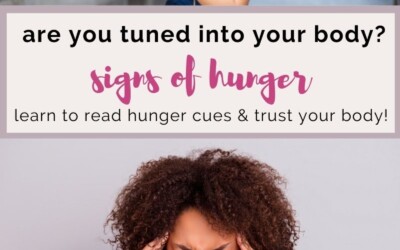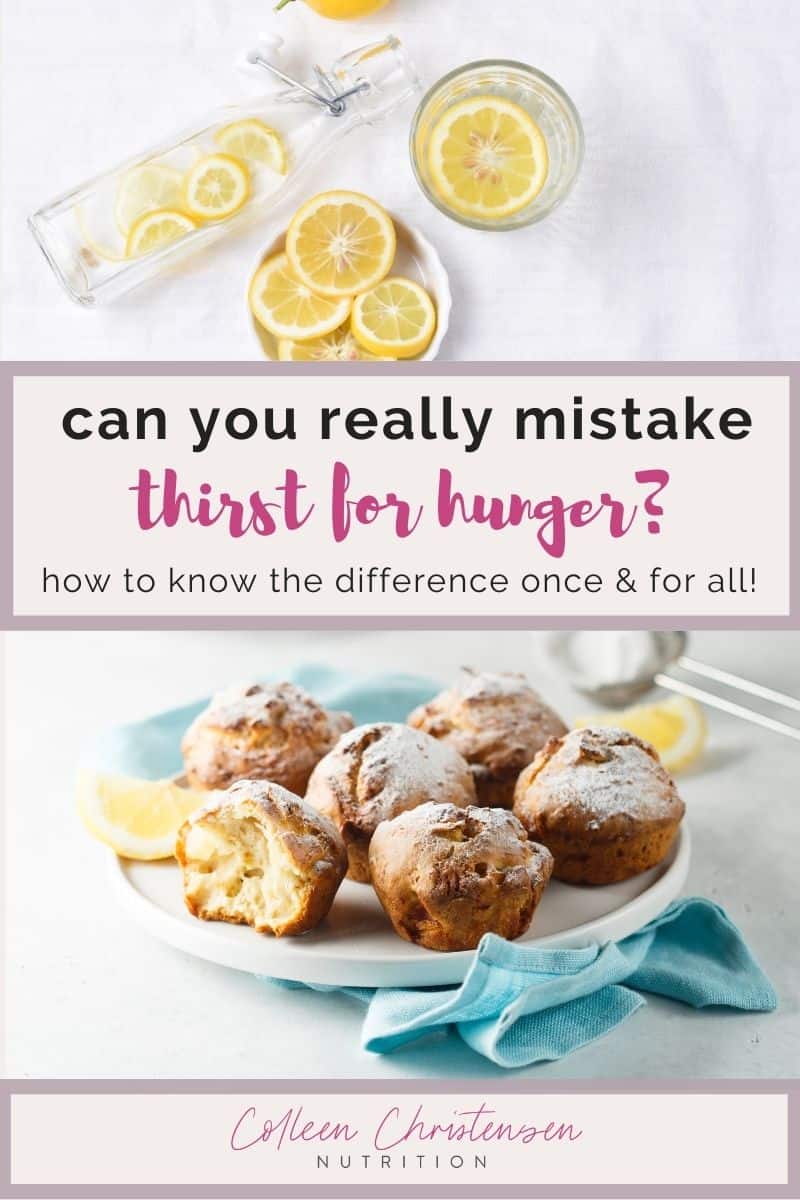Did you know that signs of hunger include far more than just a rumble in your tummy? And your signs of hunger might be completely different from mine?
Getting to know your own body, understanding her cues and building respect with your body is part of the journey of Intuitive Eating. But sometimes the things that seem the most simple on the surface are actually a lot more tricky than you’d guess. Reading your hunger cues can be one of those things!

“Eat when you’re hungry and stop when you’re full” is a lot more challenging if you’ve been a chronic dieter: you’ve been ignoring the signals that your body has been trying to communicate. And so, it takes practice to tune back in. This is what this whole post is about – learning your signs of hunger so that you can build a positive and trusting relationship with yourself.
If you’re unfamiliar, intuitive eating is a non-diet approach to eating that is based on listening to your body to meet your physical and emotional needs. (I’d highly recommend snagging a copy of the Intuitive Eating book, you can find it here on Amazon!)
Here’s what might surprise you: there are actually four types of hunger. Let’s start there!
4 types of hunger
News flash: we actually have more than one kind of hunger. Four, to be exact.
Say what?
When you think of “hunger,” you are probably thinking about physical hunger: your body is low on fuel and is asking to refill the tank: cue the rumble in the tummy (for some of us). Turns out, there are actually four types of hunger altogether.
- Biological hunger (aka physical hunger): this is your body needing a refuel because your tank is empty.
- Emotional hunger: this is what we might think of as emotional eating, but emotional hunger is not “bad,” it is simply caring for your emotions with foods that feel good to eat, such as a warm gooey cookie to soothe feelings after a rough day or enjoying cake at a birthday party to celebrate (even if you’re not biologically hungry!)
- Taste hunger: this is craving a specific type of food or drink, like wanting a specific flavor of ice-cream on a hot day or a specific type of pizza on a Friday night, regardless of biological hunger.
- Practical hunger: this is using your noggin to help take into account your schedule and availability to keep your body fed and comfortable. For example, if you’re about to go on a flight and know that you won’t have access to food for a few hours, you might eat something before you board so that you can prevent being overly hungry when you get off the plane (which likely leads to eating past fullness!). More on practical hunger here.
If you’re a podcast gal, I have an episode called Everything to Know About the 4 Types of Hunger that you can check out.
Let’s explore the physical signs of hunger next.

Physical signs of hunger
Want to know something kind of strange? We don’t all feel hunger the same way. We all get hungry and need to refuel throughout the day, but our body can try to get our attention in different ways.
When you’re used to dieting, you might not notice hunger until your body is screaming for nutrition: you’re STARVING! And your body is saying FEED ME NOW!! DO NOT DELAY! This is because we have been ignoring the more subtle, gentle cues when dieting. We were trying to subvert our hunger in order to lose weight.
With practice, you’ll be able to listen to the signals that are quieter. As you get to know your body and hunger better, you’ll be able to notice clues that you need nourishment that are more subtle.
This is like learning to kick a soccer ball right into the goal. At first, you might go wide, or too high. This is normal: you’re practicing a new skill! But with practice, you’ll be able to aim that ball exactly where you want it.
Same with reading your physical signs of hunger: if you’re out of practice, it is going to take time and practice to read them.
So: what are they? Physical signs that your body is in need of food might include:
- Rumbling in your belly
- Lower energy levels
- Feeling faint or shaky
- Headaches
And you know what else? If you’ve been dieting for a while, you might not have ANY hunger cues at the moment. Like…none. Why would your body bother trying to get your attention and communicate when she knows that you’re going to ignore her? If this sounds like you, you’ll want to check out my post How to Get Hunger Cues Back.
In the meantime, mental signs of hunger might be easier to read for you, first.

What are the mental signs of hunger?
Some of us might need to rely on mental signs of hunger first as you’re learning how to get your hunger cues back. Don’t worry: these are excellent signals to learn from, too!
Mental signs that your body is in need of food might include:
- Grumpy mood (hello, Hangry!)
- Difficulty focusing
- Anxiety
- Lower tolerance for that annoying co-worker or classmate (ugh!)
- Impatient or easily rattled
- Conditional thinking (ex: I’m allowed to have lunch if I workout first)
- Thinking about food
You might notice that you’re thinking about food and hungry all the dang time. Let’s talk about that next.
What is constant hunger a symptom of?
What’s interesting is that a lot of different factors influence how hungry we feel: it isn’t just about the food. Other factors that may increase signs of hunger include:
- You’re dehydrated
- You’re tired
- You’ve had a tough, emotional day
- You’re not giving your body the wide variety or nutrient dense macronutrients it needs and aren’t feeling satisfied (this is where Gentle Nutrition comes into play to guide your food choices that feel good emotionally and physically)
- You’re not fueling enough
Basically, there is a lot to our hunger: the signs of it, what influences it and how to know how much hunger is the right amount – for you – to feel to begin eating and when to stop.
It’s more complicated than you’d guess, right?
P.S. It is A-OK to eat if you’re not feeling signs of hunger! This is NOT the hunger and fullness diet. I talk about this nuance more in my blog post on boredom eating.
What happens when we ignore our hunger?
So, we’ve gone through the different options for what signs of hunger might feel like, for you. What if we just ignore them?
When we ignore our hunger – as we do when we’ve been dieting – your body no longer trusts you to give it nourishment when it is needed: you’ve been ignoring the cues! When you start to tune into your body and let go of dieting, you might actually feel more hungry for a while because your body hasn’t been fed regularly, when she’s asked. You might even feel like your hunger is extreme. This is normal, but it won’t last forever.
The important thing to remember is that we feel best when we are in a trusting relationship with our body, including our hunger. Do we feel like a failure as a human being if we get out of the hot sun when our body is telling us that we need a break? Or to go to the bathroom when we need to pee? I highly doubt it. Eating when hungry should have no more morality than the first two examples, but our society makes it easy to assign value to our eating choices and to beat ourselves up. This blog post is an invitation to kick dieting and food morality to the curb and tune into your signs of hunger. You’re worth it!
If you’re looking for more guidance on how to overcome food rules and to snag the same hunger scale that I use myself and give to my clients, be sure to snag my free e-book, The Ultimate 5-Step Guide To Food Freedom!
-XOXO
Colleen










Leave a Reply